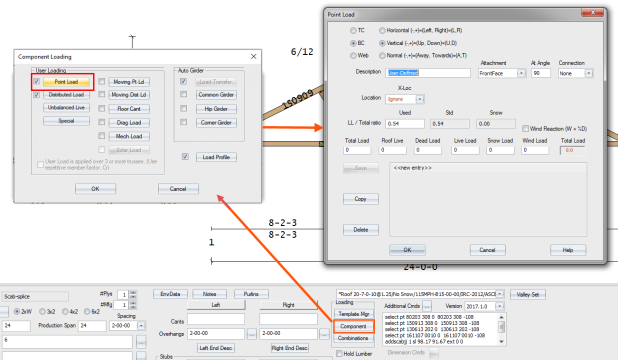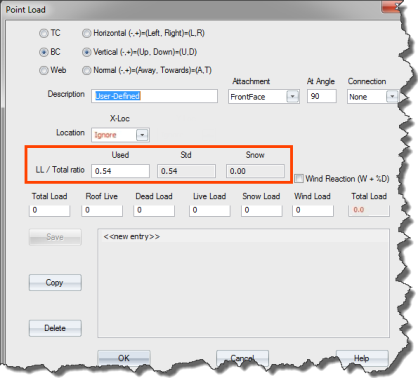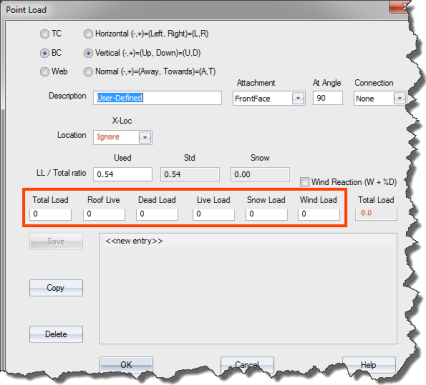Purpose
To create point loads
Steps
![]() Watch video - Improvements to Load Dialogs
Watch video - Improvements to Load Dialogs
To create point loads:
1. Click Component to open the Component Loading window. Then click Point Load to open the Point Load window.

The check mark next to the Point Load button lets you enable/disable Point Loads.
2. In the Point Load window, define the following options. Options in red (Location and Total Load) are required:
- Select a member (TC, BC, or Web) and direction (Horizontal, Vertical, Normal)
- Enter an optional description for the load. If you Tab to the next field, the cursor moves to the Location field.
- Attachment - location to attach load. Loads are assumed to be front face if not defined specifically to be on the back.
- At Angle - enter an angle
- Connection - select a connection type (None, Hanger, Custom, Nailed)
- Location - this is a required entry. The Y location appears when the Web member option is checked.
- LL/Total ratio - allows you to specify a Live Load to Total Load ratio to split the load into parts. The program defaults to the ratio suggested by the current Load Template; Std displays the default ratio. If you do not want to use the default ratio, enter a different number in the Used box.

 If snow load is enabled in the current Load Template, and the snow PSF is greater than the standard Live load PSF, the LL/Total ratio is calculated using the snow load PSF as "live" and the snow + dead loads as the total.
If snow load is enabled in the current Load Template, and the snow PSF is greater than the standard Live load PSF, the LL/Total ratio is calculated using the snow load PSF as "live" and the snow + dead loads as the total.
- Wind Reaction - If this box is checked, you must enter a wind reaction. Truss Studio automatically takes this value and subtracts a 60% dead load to determine the actual wind part that needs to be applied, assuming any dead load is specified in the Dead Load box.
- The following load boxes let you enter a Total Load, split by the LL/Total ratio specified into Live and Dead components; alternatively, you can specify an individual load in each box. Depending on the truss and the Load Template used, all or some of the load boxes may need entries. Truss Studio takes an educated guess at completing the values in each load box. You can accept the program-supplied values or edit them. You can also supply the loads in the specific boxes directly, instead of using a Total Load entry.

- The values entered in Roof Live, Dead Load, Live Load, Snow Load, and Wind Load are saved to the truss file and can be edited later. Each type of load, with appropriate factors applied as determined by Load Combinations, will automatically be added to the appropriate loadcases using that type of load.
If you modify or enter loads into the individual load boxes, whatever is entered is the partial load. For example, you enter 400 in the Roof Live box, 200 in the Dead Load box, and -100 in the Wind Load box, that corresponds to exactly what is used for the Load Groups and Loadcases/Combinations, with the exception that all factors still need to apply, like 60% of the dead load for wind cases. It is not necessary to enter a value in all the boxes. If any one box has a value other than zero, that is acceptable, and that will be the only load applied to the truss. Each load box is combined concurrently with all program-generated loads of the same type.
If you enter a Total Load, Truss Studio assumes this is a total load based on the typical loading selected in the current LP. For example, if the current standard loading is 30-7-0-10, that information is used to split the given load magnitude into its constituent load parts. In this case, assume a 500 lb. entry is made. The total load is based on 30+7+0+10 = 47 PSF total. The Roof Live load portion of that is the ratio of 30/47 of 500# = 319.15#. The Dead Load is the rest, in this case, 500 - 319.15 = 180.85#. The live load should be assumed to be Roof Live or Snow or Floor Live, depending on the type of LP in use and the Load Template settings (which options are turned on or off).
3. Click Save to save the point load settings. Click OK to close the window. After you save a point load, you can use Copy to copy and edit the load case to create a new load case.
 Note: If you click OK without first clicking Save, you are prompted to save your changes before closing the dialog.
Note: If you click OK without first clicking Save, you are prompted to save your changes before closing the dialog.
4. After you apply a point load, on the Component Loading window, check the option to Use repetitive member factor if the load is applied over three or more trusses.
5. Click OK to close the Component Loading window.